This REU site is now closed. Our 3 years of NSF funding ended in 2018. There will be no further applications accepted.
2017 Student Research Symposium
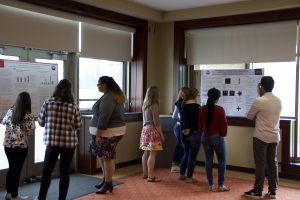
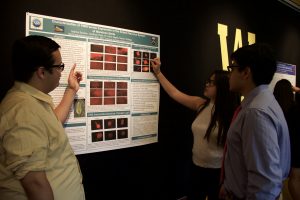
9:15 -10:35 am: Student Research Presentations
9:15 – 9:30 am: Jessica Meza and Dr. Grit Herzmann (mentor) “Differences in Configural and Parts Processing in Relation to the Other Race Effect”
9:30 – 9:50 am: Jonathan Palacios Alvarez and Dr. Harry Itagaki (mentor) “Influence of gut microbiota on FMFRmide expression in Manduca sexta enteric nervous system”
9:50 – 10:20 am: Leonora Akporyoe, Olivia Galinzoga, Emma Hoffmann, Khyrul Khan, Maren Schroeder, and Dr. Robert Rosenberg (mentor) “Changes in excitability protein expression during the first week after spinal cord injury in lamprey”
10:20 – 10:35 am: Naomi Ongjanco, Yamelli Puente and Dr. Beth Mechlin (mentor) “Stressed? Should you meditate or eat ice cream?”
10:45 – 12:00 pm: Keynote Address; Dr. Jon Niemi, Case Western Reserve University Department of Neurosciences post-doctoral research fellow, in the lab of Dr. Richard Zigmond. Inflammation Isn’t Always Bad: The Immune System Supports Peripheral Nerve Regeneration
12:45 – 2:00 pm: Student Poster Session
Ethan Bradley and Dr. Sarah Petersen (mentor). “Chemical screening in zebrafish to reveal small molecules that regulate myelination”
Rachel Brandon and Dr. Amy Jo Stavnezer (mentor). “The effects of hormone replacement therapy on learning and memory in multiparous rats.”
Melanie Kacin and Dr. Grit Herzmann (mentor). “Configural and featural perception of familiar same- and other-race faces.”
Lekha Medarametl (Hathaway Brown School), Dr. Brad T. Casali, Dr. Monica M. Mariani, Dr. Gary E. Landreth (Case Western Reserve University mentors). “Effects of Bexatrotene on neuroinflammation in an AD mouse model.”
Jonathan Papa, Sabrina Serrano and Dr. Harry Itagaki (mentor). “Characterization of FMFRamide expression in the enteric nervous system of Manduca sexta.”
Kristen Pitts and Dr. Sarah Petersen (mentor).“Characterization of a zebrafish peripheral myelination mutant.”
Carrie Ponder and Dr. Amy Jo Stavnezer (mentor). “Pilot assessment of frequency specific microcurrent therapy on an ADHD-strain of rats.”
Yamelli Puente, Naomi Ongjanco, and Dr. Beth Mechlin (mentor). “Is Netflix more chill?”
Sydney Quinn and Dr. Suren Ambegaokar (mentor). “Effects of physiological stress on hnRNP K gene expression in the Drosophila brain.”
Kathy Wang (Hathaway Brown School), Dr. Jon P. Niemi, Dr. Alicia DeFrancesco, Dr. Richard E. Zigmond (Case Western Reserve University mentors). “Site-specific role of macrophages in peripheral nerve regeneration and degeneration.”
2:15 – 3:45 pm: Student Research Presentations
2:15 – 2:25 pm: Erika Beyrent and Dr. Suren Ambegaokar (mentor). “Effects of miR-7 on Tau Expression.”
2:25 – 2:40 pm: Mary Cranley and Dr. Suren Ambegaokar (mentor). “CRISPR/Cas9 Nickase and knocking out Heme Oxygenase-1 in Vero cells.”
2:40 – 3:00 pm: Momi Afelin and Joe Emerson and Dr. Chris Fink (mentor). “Computational kodeling of seizure propagation.”
3:00 – 3:20 pm: Anne DeHart, Anoohya Muppirala, and Dr. Sarah Petersen (mentor). “From screen to gene: Characterizing two putative myelin mutants in Danio rerio”
3:20 – 3:40 pm: Abdusalem K. Awol & Olivia Pearl Wallace and Dr. Michelle Tong (mentor) “Effects of odor similarity on the learning and memory of olfactory discrimination”
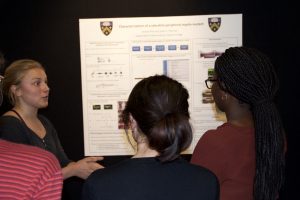

2016 Student Research Symposium
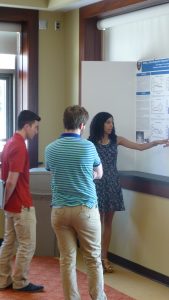

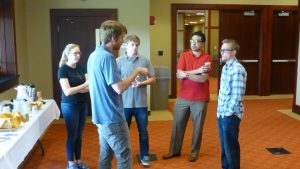
Student Research Presentations
Greta Minor and Dr. Grit Herzmann (mentor) “The Effects of Attention and Holistic Processing on the Other-Race Effect in Face Memory”
Being able to recognize faces accurately is important for daily social interactions, but this ability is compromised by something called the other-race effect, a phenomenon by which other-race faces are not recognized as well as own-race faces. Previous studies have shown that event- related potentials (ERPs) associated with recollection and familiarity during memory encoding and retrieval (Dms, parietal old/new effects) exhibit different patterns for own-race and other- race faces, but the reasons behind these differential patterns are controversial. The present study investigated the potential roles of attention and holistic processing on the other-race effect in a remember-know task, in which Caucasian participants learned and recognized own-race and other-race faces. Participants were placed into either the attention manipulation, which had a focused attention condition and a divided attention condition, or the holistic processing manipulation, which had an upright presentation condition and an inverted presentation condition. Replications from prior other-race studies indicated that memory encoding for own- race faces was more efficient in the upright presentation condition and focused attention condition, across both attention and holistic processing experiments. Novel results were found in the comparison between upright and inverted presentation conditions of the holistic processing experiment; similar encoding mechanisms were used for upright other-race faces and inverted own-race faces, as evidenced by the similar level of activation and distribution of memory effects for these faces. The attention manipulation yielded no such results, indicating that holistic processing, but not attention, modulates the other-race effect during memory encoding.
Michael Kahl and Dr. Seth Kelly (mentor) “Understanding the role neuronal development plays in intellectual disability“
Brian Jordan, Brooklyn McCue, Austin Minnick, Cemaliye Semmedi and Dr. Jennifer R. Yates (mentor). “Effects of 6-Chloro-Tryptophan on Acute Spinal Cord Injury in Guinea Pigs”
Inflammation contributes to the secondary behavioral deficits seen in neurotraumatic injuries such as spinal cord injury (SCI). The current approved treatment for SCI primarily exists as an antioxidant that fails to reduce inflammation. Inflammation in acute SCI is associated with the production of the neurotoxin, quinolinic acid (QUIN). QUIN is produced by activated macrophages at the injury site and its accumulation is correlated with injury severity. Previous studies have shown that manipulating the tryptophan-kynurenine pathway, which leads to the production of QUIN, can attenuate QUIN accumulation and reduce secondary behavioral deficits after SCI. One way to manipulate this pathway is by administering 6-chloro-tryptophan. In the present study, the effects of 6-chloro-tryptophan on secondary behavioral deficits and QUIN accumulation were investigated in a guinea pig model of SCI. Adult female Hartley guinea pigs were injured by lateral compression of the spinal cord at the 12th thoracic segment (T12). 6- chloro-tryptophan was administered in doses of 1 mg, 5 mg, 7.5 mg, and 10 mg over a time period of either 3 or 7 days, beginning at 5 hours post injury. The severity of the behavioral deficits and the recovery rate of the subjects were quantified using several sensory and motor function tests, including Cutaneus Trunci muscle reflex, toe-spread, proprioceptive placing etc. Doses between 5-10 mg showed trending improvement in recovery rate. Supplementary histological analysis will be required to quantify QUIN accumulation at the injury site. In order to consider the drug viable, further experimentation will be conducted.
Xuzhou He and Dr. Pamela Pyzza (mentor) “Dynamics of Integrate-and-Fire Model of Hippocampal Circuit”
The behavior of neuronal networks in the hippocampus is the topic of many experimental and modeling studies, and yet much of these networks’ structures and functionalities in this part of the brain are not well understood. We can use computational models to reproduce some of the hippocampal behavior seen experimentally and begin to investigate possible underlying mechanisms for the network activity. A common computational neuron model used for modeling such networks is the Hodgkin-Huxley (HH) neuron, which can describe the spiking behavior of a single neuron very well. However, the complexity of this model, compounded by network properties makes network simulations with HH computationally expensive. In this work, we will focus on the network dynamics, rather than individual neuron properties and consider a simpler, more computationally efficient model called the integrate-and-fire (I&F) neuron. Motivated by experimental work, we consider a network of three types of neurons: fast excitatory neurons, fast inhibitory interneurons, and a slow inhibitory neuron based on the oriens lacunosum-moleculare (O- LM) cell whose interactions are believed to be responsible for network oscillations measured in the characteristic gamma and theta frequency bands. We investigate parameter regimes for the coupling coefficients, external spike input, and other parameters, in which our model can qualitatively reproduce the behavior seen in other computational models, as described in Kopell et al. (2010), which employ the HH model. We further consider network dynamics created by various network architectures including all-to-all coupled and sparse network connectivity to begin to make links between network properties and network behavior.
Jemil Ahmed and Dr. Suren Ambegaokar (mentor) “RNAi as an Antiviral Mechanism”
Vesicular stomatitis virus (VSV), part of Rhabdoviridae, can cause severe illness in many important livestock, such as horses, cattle, and sheep. Curcumin (CUR) is a polyphenolic extract from the spice turmeric, and has a variety of pharmacological benefits including anti- inflammatory, antioxidant and anti-viral activities. However, there is limited work on its effects on VSV infection, or a mechanistic description of its anti-viral properties. The initial goal of this study was to determine if CUR could restrict VSV infection in Vero cells, and if so, to determine the minimal concentration required for restriction. We observed that 10mM of CUR provided robust inhibition of recombinant VSV-EGFP infection of Vero cells, as measured via plaque assay and fluorescence, with approximately 33% reduced infection at MOI 0.0002 and nearly 90% reduction at MOI 0.00002 after 24 hours. We hypothesized RNA interference (RNAi) mechanisms may be effective at restricting VSV infection, and measured Dicer-1 mRNA via qPCR. We found cells infected with VSV-EGFP and treated with CUR had higher levels of Dicer-1 expression than VSV-EGFP infected cells treated with vehicle (DMSO); b-Actin was used as reference gene. Preliminary results indicate CUR alone has limited effect on Dicer-1 expression in the absence of VSV infection. This may indicate that VSV infection itself alters Dicer-1 expression; CUR restriction of VSV infection may rescue the effect on Dicer-1 expression by inhibiting VSV replication through an as yet unidentified mechanism. It is know that VSV infection induces oxidative stress to promote apoptosis, and thus the antioxidant properties of curcumin may be the primary effect on VSV restriction, which future studies will investigate.
Josué Parr, Henry Quillian, and Dr. Andrew Engell (mentor) “Can You See Me Now? An EEG Investigation of Non-Conscious Face Processing”
Humans glean a wealth of social information from faces, making efficient detection of conspecific faces evolutionarily advantageous. It has therefore been suggested that the brain might detect and process faces non-consciously. However, evidence supporting this notion is equivocal. This is, in part, due to the methodological challenge of presenting faces without conscious perception for adequate durations to acquire signal with sufficient signal-to-noise. In the current EEG experiment, we addressed these issues by using a novel combination of binocular rivalry with continuous flash suppression (CFS) and fast periodic presentation (FPP). A flashing checkerboard was presented to one eye while our stimuli of interest were presented to the other. The flashing checkerboard tends to dominate conscious perception and thus keeps the images presented to the “suppressed” eye unperceived. Images were presented to the suppressed eye at a frequency of 6 Hz. Every 5th image was a face (face presentation frequency = 1.2 Hz). Participants were instructed to terminate the presentation via button press if they became aware of the stimuli being presented to the suppressed eye. The identical experiment without CFS (i.e., stimuli were perceived) served as our control condition. A fast-Fourier transform was used to convert the EEG data into the frequency-domain. In the control condition, we observed a spike in power at the face presentation frequency (1.2 Hz) at occipitotemporal electrodes. Critically, no such spike was observed when the faces were presented non-consciously. The unambiguous results of the current study strongly suggest that face-selective cortical processing requires conscious perception.
Noah Armstrong and Dr. Seth Kelly (mentor) “The Role of PKA Regulation During Sleep Deprivation”
Madi Hunt, Grace Ishimwe and Dr. Grit Herzmann (mentor) “The effect of race and familiarity on ERP correlates of famous face memory”
Numerous ERP studies have proven that a face of one’s own race is easier to recognize than a face of another race. This is known as the other race effect. This study uses ERPs to determine how familiarity and memory from past experience impact the other race effect. Using an EEG machine, ERPs of 27 Caucasian participants were recorded as they watched and reported their familiarity with images of celebrities and non-celebrities. The most important ERP for face recognition is N250 and it was used to determine structural representations of faces, and N250r was used to measure memory through the priming technique. Participants were given a survey prior to the EEG recording in order to determine which celebrities a participant is most familiar with. Then, according to the results of the survey, a participant received a customized image bank based on who the participant knows and doesn’t know. The image bank contained pictures of celebrities from own and other races that are familiar to the participant, and pictures of people from own and other races that are unfamiliar to the participant. In order to measure the memory aspect of the hypothesis, the priming technique was used by presenting a prime face followed by a target face. The results showed that the other race effect was present on unfamiliar non- celebrity faces, however, it was greatly reduced on familiar celebrity faces. The same trend was evident in primed faces. These results indicated that familiarity and memory from past experience impact face perception and therefore influences the other race effect.
Student Poster Sessions
Sarah Naguib and Dr. Hewlet McFarlane (mentor) “GABAA2 Subunit Agonism Improves Social Memory in BTBR T+tf/J Mice”
Autism Spectrum Disorder is an illness characterized by aberrant social interactions, communication deficits and repetitive behaviors (McFarlane et al., 2008). The BTBR T+tf/J (BTBR) is an inbred mouse strain that has been demonstrated to possess several hallmark behavioral phenotypes of Autism Spectrum Disorder, including reduced social interactions and impaired social recognition (McFarlane et al., 2008). One of the characteristic hallmarks of this strain of mice is its reduced level of inhibitory neurotransmission in comparison to their C57BL/6J (B6) counterparts (Han et al., 2014). The primary mediator of inhibitory neurotransmission in the brain is the neurotransmitter GABA acting on its receptors, particularly the GABAA. Thus, it is likely that autistic-like behaviors in these BTBR mice could result from these decreased levels of inhibitory neurotransmission (Han et al., 2014). Previous findings in our laboratory have indicated that selective subunit activation of α2 significantly improves spatial memory in the BTBR mice (Yoseph and McFarlane, unpublished). The current study assesses the hypothesis that α2 stimulation will improve social memory deficits in the BTBR mouse model as well.
Kelsey Hauser, Kia Barclay, and Dr. Hewlet McFarlane (mentor) “Unusual Locomotor Response to Morphine Treatment in BTBR +tf/J Mice”
Autism Spectrum Disorder (ASD) is a neurodevelopmental disorder associated with several cardinal traits including social interaction deficits, communication deficits, and high anxiety levels. There is evidence to suggest that motor coordination deficits should also be considered a core feature (Fournier et al., 2010). The BTBR T+tf/J (BTBR) strain of mice serve as a model for autism, exhibiting many of these core features (McFarlane et al., 2008). It has been hypothesized that the underlying pathology of autism involves a dysfunctional pathway of motivation and reward (Becker et al., 2014). Increased striatal dopamine is thought to be involved in normal social reward processing (de la Fuente-Fernández et al., 2002). Previous studies in our laboratory have shown decreased dopamine levels in the striatum of BTBR mice. Opiates are known to induce motor hyperactivity by increased striatal dopamine output (Kuschinsky & Hornykiewicz, 1974). The present study investigated the hypothesis that diminished striatal dopamine in the BTBR mice will translate to diminished locomotor response to systemic opiate treatment, relative to C57BL/6 (B6) controls.
Brooke Martineau, Sean McCartt, Kevin Rossi, and Dr. Kira Bailey (mentor) “Gotta go fast: The effects of video games on response time”
Improvements in visuospatial processing have been shown following as little as 10 hours of playing action video games (AVGs; Green & Bavelier, 2003); however, other work suggests these same games may have a negative impact on cognitive control, the ability to flexibly adapt behavior to meet task demands (Bailey, West, & Anderson, 2010). Few studies have examined the impact of other genres of video games on cognitive control. The goal of the current study was to replicate and extend previous work examining the effects of action video games on cognitive control, and to examine the effects of a previously unstudied genre, real-time strategy (RTS) video games. Neural (event-related brain potentials) and behavioral (response time and accuracy) correlates of cognitive control were measured before and after 10 hours of training on either an AVG (Unreal Tournament 3) or an RTS (League of Legends). Data collection is ongoing, but at this time there are minimal differences pre and post-training in both the AVG and RTS groups.
Sarah Mohr, Anxu Wang, and Dr. Andrew Engell (mentor) “The Effect of Isolated Facial Features on the Identity Sensitive n250r ERP”
One of the earliest neural markers of familiar face perception is the n250r event-related potential (ERP), recorded primarily from inferior occipitotemporal electrodes. This ERP is evoked by a target face, which is presented some time after the presentation of a prime face. If the prime and target faces are the same identity, there will be a pronounced negative deflection in the waveform at 200 – 300 ms after the onset of the target face. The n250r is observed, albeit smaller, even when the prime and target images are of the same individual taken at different angles or expressing different emotions. It has therefore been proposed that the n250r reflects the matching of a perceptual representation of a face to a stored memory representation of that face. It is currently unknown whether face parts, such as eyes and mouths, are effective primes capable of producing the n250r. We investigated this by presenting full faces, eyes, and mouths of famous celebrities in three priming conditions: same identity-same image, same identity-different image, and different identity. Full-face primes evoked the n250r in both the same identity-same image and same identity-different image conditions. The face-part primes, however, did not evoke a significant n250r (though there was a non-significant trend for eye primes). These results suggest that early face identification mechanisms rely on holistic perception of the face and are thus not effectively engaged by the perception of isolated face parts.
Ksenia Klue, Mihaela Paula Suciu and Dr. Suren Ambegaokar (mentor) “The Role of miR-7 in Neuronal Differentiation”
MicroRNAs (miRNAs) are negative regulators of gene expression. Previous research has found microRNA-7 (miR-7) expression may be altered in neurobehavioral disorders such as schizophrenia or Alzheimer’s disease; however research is inconclusive as to its role. Previous data have also found expression in developing brains of animals, but there are uncertainties as to whether miR-7 promotes or inhibits neuronal differentiation, or if miR-7 expression has any effect at all on neuronal differentiation. Our research uses SH-SY5Y cells, which are human glioblastoma cells that have neuronal progenitor-like properties, in that they can be induced to differentiate into neuron-like cells when treated with retinoic acid (RA). We examined if miR-7 expression changes during the course of differentiation. We also examined if overexpressing miR-7 was sufficient to induce neuronal differentiation, as measured by morphology and expression of neuronal-specific genes. We found miR-7 expression goes down during differentiation. In support of this, miR-7 overexpression was not sufficient to induce differentiation; however expression of some neuronal markers increased, which suggests miR-7 may have a partial and more complex role in differentiation. This research will better inform our understanding of microRNA function, and the potential use of miRNAs as therapeutic targets in neurobehavioral disorders.
